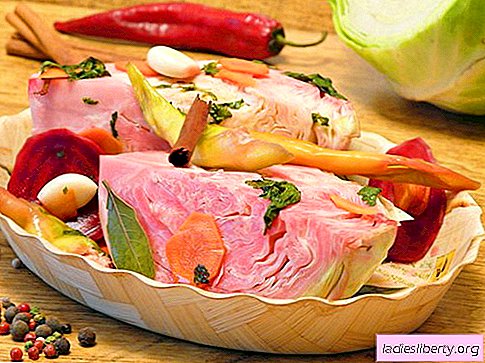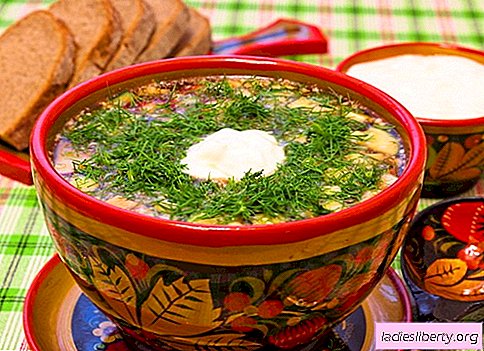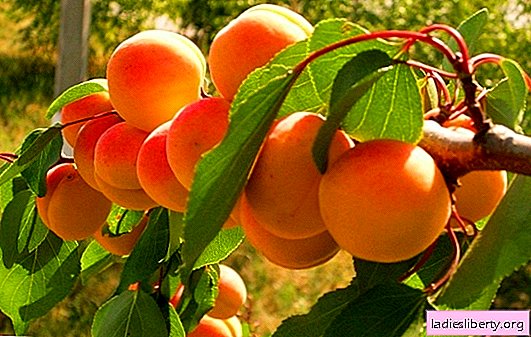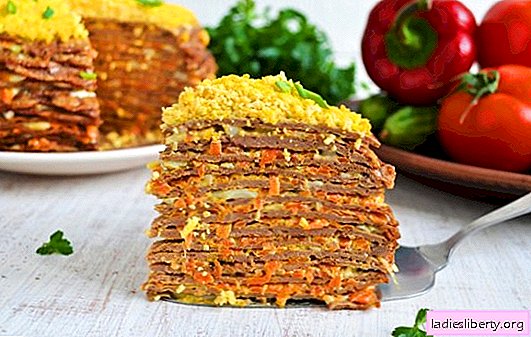
Salting cabbage - general principles and methods
Many housewives do not see the difference between pickling and sauerkraut. Indeed, the two processes are similar. The only difference is that when salting vegetables according to the recipe, a greater amount of salt is put than when leavening, and the process of salting occurs faster, in about three to five days. While sauerkraut should be well degraded, which takes up to two weeks. Excess salt slows down the fermentation process, so pickles have less lactic acid than pickled vegetables. Acid and salt contained in salted cabbage kill more microorganisms and putrefactive bacteria, so it is stored longer. The amount of salt does not affect the deterioration of taste. The salted cabbage turns out to be crispy, with a delicate and pleasant sweet and sour taste.
Salting cabbage - preparation of products
For salting, take tight white heads of cabbage of late varieties, without damage. The forks are cleaned of the upper leaves, usually they are more lethargic and have a greenish tint. Then cut into thin strips. Now there are many devices for the mechanical grinding of vegetables. So you can chop the cabbage using a vegetable cutter, a special grater, in a food processor or an ordinary knife. Before shredding, the knife must be sharpened well - and the process will go faster and the straw will come out finer. Spices that will be used for salting, it is necessary to sort out, remove rotten and spoiled leaves and twigs and rinse.
Salting cabbage - the best recipes
Recipe 1: Salting cabbage with dill grains
Such a cabbage with a mildly sour taste will be pleasant to crunch under hot fried potatoes on cold winter nights. Cabbage must be chopped with thin and long strips similar to spaghetti.
Ingredients: cabbage - 2 medium-sized heads of cabbage, 3 carrots, salt - 2 tbsp.spoons with a slide, 1 tbsp. l dry dill grains
Cooking method
Cut cabbage into two unequal parts - with and without cob, and chop. You can put a half fork on the edge or put flat on the table, as you like. The stump and the area around it with coarse fibers do not need to be cut.
Fold the slices into a wide dish so that it is convenient to interfere - a bowl, or a large pan, add salt and mash thoroughly. So that salt does not corrode the skin of the hands, and for hygiene purposes, it is better to wear disposable gloves (or plastic bags). Add dill seeds, grated carrots, mix.
Set the load on top and put the cabbage on the balcony or other cool place, but not in the refrigerator. The role of the load at home is usually played by an inverted flat plate on which a small kettlebell, bottle or jar of water is placed. In our case, you will need a three-liter jar filled with 2/3 of water.
The fermentation process has already begun, so twice a day, the contents of the pan must be freed from the gases accumulated at the bottom of the dishes, otherwise the cabbage will turn out to have a bitter taste. To do this, remove the load, mix the mass with a spoon, leave for a couple of minutes and return the oppression to its place. Three days later, the cabbage is laid out in a smaller container and transferred to a refrigerator or cellar, if any.
Recipe 2: Pickled Cauliflower
It just so happened that if it comes to sourdough or pickling cabbage, then they basically mean white cabbage. But this recipe for cauliflower, it is also suitable for salting and it turns out no less, if not more tasty, than traditional white cabbage. To make the dish look more beautiful, it is better to chop carrots on a grater for Korean carrots. This condition is not mandatory; it is advisory in nature. Cabbage should be selected dense, white. Yellowish inflorescences indicate that the cabbage is slightly overripe, and is not quite suitable for salting. Which is not the best way to affect the appearance and taste of the finished dish.
Ingredients: cauliflower - 2 forks, carrots - 0.5 kg, 5-6 grains of garlic, black pepper, 4-5 bay leaves. For brine - per liter of water: 1 tbsp. tablespoon of salt with a slide, incomplete (without a slide) tablespoon of sugar.
Cooking method
Prepare a brine, for which stir salt with sugar in water, boil and cool.
Disassemble the forks into large inflorescences and blanch for a minute and a half, i.e. lower for this time in boiling water. It is not necessary to hold for a long time, otherwise the cabbage will turn out not crispy, but cotton. Then the inflorescences should be cooled under water and lay in layers in a bowl for salting. Transfer layers with grated carrots, chopped garlic, pepper, a couple of bay leaves. The first and last layers are carrots.
Pour the cabbage with brine and set the load. Leave warm (in the kitchen) for a day or two, then transfer to the balcony. Cabbage will salt out after 4-5 days. It is transferred to banks, which are placed in the refrigerator.
Recipe 3: Salting Cabbage with Beets
Such a cabbage is not only very tasty and crispy, but also looks elegant in a plate and on a table. After all, she differs from her pale sister in a beautiful raspberry color.
Ingredients: 2 large fork of cabbage - 4 kg, 2-3 beets, a whole head of garlic, 1-2 horseradish roots. For brine in 2 liters of water: 100 g of salt, ½ cup sugar, 4 bay leaves, 2 cloves of cloves and 10 peas of black pepper.
Cooking method
Boil water, putting all the ingredients for brine there, cool.
Chop cabbage arbitrarily, at your discretion - thin straws or large pieces, not forgetting to remove the stalk. Grind garlic and horseradish root - on a grater or through a meat grinder, cut beets into medium-sized cubes. Mash the cabbage with your hands and mix with horseradish and garlic, then put it in a bowl for salting, pouring cubes of beets. Pour the beet-cabbage mass with brine, set on top oppression and leave for fermentation. Mix cabbage once or twice a day to remove accumulated gas bubbles. In two to three days, the cabbage is ready. It is transferred to banks and put in a cold place - a cellar, a subfloor or a refrigerator.
Salting cabbage - useful tips from experienced chefs
- For high-quality salting of cabbage, it is necessary to choose the right salt. Only coarse rock salt is used, iodized or Extra (fine grinding) is not suitable.
- During fermentation, the brine should completely cover the cabbage. If the brine is not enough, the mass of the load must be increased (add to a jar of water or put a weight of greater weight).
- To make the cabbage juicy and crispy, it is recommended to salting it on the growing moon.











